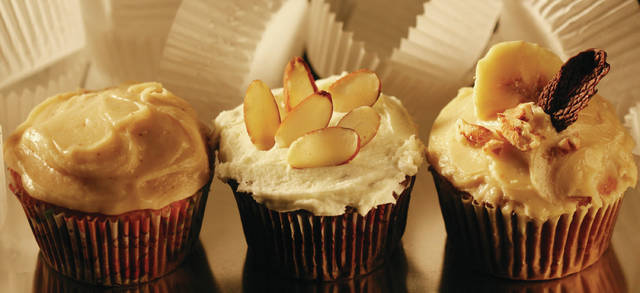Q: When you freeze bananas, should you peel them? What is the best way to defrost them and should them be drained?
Q: When you freeze bananas, should you peel them? What is the best way to defrost them and should them be drained?
— Sue Ritter
A: If there is one cool thing about bananas, it’s that they freeze wonderfully. And they keep just fine in the freezer for about three months. Freezing is a way to preserve bananas that have reached their ripeness peak or are close to overripe. Rather than tossing them because you can’t eat them out of hand, freeze them to use in making quick breads, muffins and smoothies.
You can freeze them whole with the peel on or off. The outer peel will turn dark in the freezer, but won’t affect the flesh. When ready to use, take them out of the freezer to defrost. It’s best to put them in a bowl because some liquid will leach out.
When freezing bananas whole in the peel, all you need to do is put them in a freezer-quality plastic bag and freeze. Squeeze the air out, seal the bag, label and date.
To freeze whole peeled bananas, put them on a tray and stick them in the freezer until they are almost frozen. Transfer them to a plastic bag. Because they are individually frozen, you can take out only what you need.
Mashed banana can also be frozen in bags or freezer-safe containers. Don’t puree the bananas, just mash with a fork to keep some texture. For each cup of mashed banana, add one tablespoon of lemon juice or 1/2 teaspoon ascorbic acid to prevent browning. A medium banana will yield about 1/2 cup mashed.
Bananas that are just hitting the ripe stage are also ideal for freezing for a treat. Stick wooden skewers or craft sticks in one end and place bananas on a tray. Melt some chocolate. Dip whole, sliced or chunked bananas in the chocolate. Place on a parchment-lined tray and freeze until solid.
Try today’s recipes from our archives using mashed bananas. Mashed bananas are not just terrific in breads and other baked goods, try them in pancake batter.
^
Banana Cupcakes with Caramel Buttercream Frosting
Makes: 28 / Preparation time: 15 minutes / Total time: 1 hour 15 minutes
3 cups sifted cake flour (not self-rising)
1 1/2 teaspoons baking soda
3/4 teaspoon baking powder
3/4 teaspoon salt
1 teaspoon ground cinnamon
6 ounces (1 1/2 sticks) unsalted butter, softened
1 1/2 cups packed light-brown sugar
3 large eggs
4 very ripe large bananas, mashed (about 2 cups), plus sliced bananas for garnish
3/4 cup low-fat buttermilk
1/2 teaspoon pure vanilla extract
1 cup chopped pecans
^
Caramel Buttercream Frosting
1/2 cup plus 2 tablespoons sugar
1/4 cup water
1/4 cup heavy cream
Swiss Meringue Buttercream (recipe below)
Preheat the oven to 350 degrees. Line standard muffin tins with paper liners. In a large bowl, combine the flour, baking soda, baking powder, salt and cinnamon. In a mixing bowl, cream together the butter and sugar until light and fluffy, about 3 minutes. Add the eggs, one at a time, beating well after each addition.
In a separate bowl, mix together the mashed bananas, buttermilk and vanilla.
Add the flour mixture in 3 additions, alternating with the banana and buttermilk mixture, beginning and ending with the flour. Stir in the pecans. You can leave out a small amount of chopped pecans to sprinkle on the tops, if desired.
Scrape sides of bowl. Divide the batter among muffin cups, filling each 3/4 full. Bake for 25 minutes. Remove from oven and cool.
To make the frosting: Bring 1/2 cup plus 2 tablespoons sugar and the water to a boil in a medium saucepan. Wash sides of pan with a wet pastry brush to prevent sugar crystals from forming. Cook, undisturbed, until caramel is dark amber. Remove from heat and add cream slowly, stirring with a wooden spoon until smooth. When cool, fold in Swiss Meringue Buttercream.
Once cupcakes are cool, frost tops with caramel buttercream. Frosted cupcakes will keep, covered and refrigerated, for up to 3 days. Top with banana slices before serving.
Adapted from Martha Stewart Living magazine, February issue. Tested by Susan Selasky for the Free Press Test Kitchen.
Analysis per 1 cup cupcake with 2 tablespoons frosting.
319 calories (51 percent from fat), 19 g fat (10 g saturated fat), 37 g carbohydrates, 3 g protein, 170 mg sodium, 62 mg cholesterol, 40 mg calcium, 1 g fiber.
^
Swiss Meringue Buttercream
Makes: 5 cups / Preparation time: 30 minutes / Total time: 30 minutes
1 cup plus 2 tablespoons sugar
5 large egg whites (at room temperature)
1 pound (4 sticks) unsalted butter, softened, cut into pieces
1 1/2 teaspoons pure vanilla extract
In a heat-proof bowl, place the sugar and egg whites. Set bowl over a pan of gently simmering water, and whisk until sugar has dissolved and mixture registers 160 degrees, about 6 minutes.
Transfer the mixture to the bowl of an electric mixer. Using the whisk attachment, beat on high speed until mixture has cooled completely and formed stiff and glossy peaks, about 10 minutes.
Add the butter, one piece at a time, and beat until incorporated. If the buttercream appears curdled after all the butter has been added, don’t worry. It will become smooth again with continued beating. Add the vanilla, and beat just until combined.
Switch to the paddle attachment, and beat on the lowest speed to eliminate any air pockets, about 5 minutes. If using buttercream within several hours, cover bowl with plastic wrap and set aside at room temperature in a cool environment. Or transfer to an airtight container and store in the refrigerator, up to 3 days. Before using, bring buttercream to room temperature and beat on the lowest speed with the paddle attachment until smooth, about 5 minutes.

